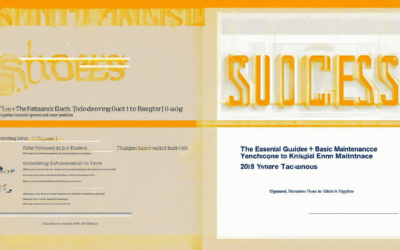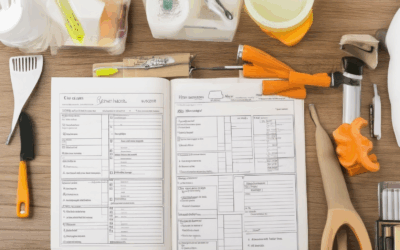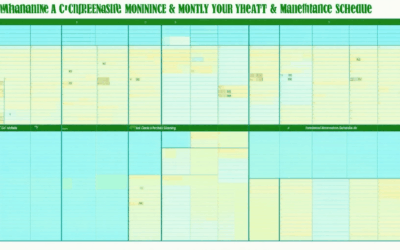Maintaining your home requires consistent effort to prevent minor issues from escalating into major problems. With the right yearly home care tips, you can keep your property in excellent shape, ensuring longevity and safety. Whether it’s adhering to the 1% rule for home maintenance or creating a personalized schedule, staying proactive is key. Regular checks on critical areas like plumbing, HVAC systems, and appliances can save you from costly repairs down the line. By allocating a portion of your budget for home maintenance, you can address these tasks effectively. This guide offers actionable advice to help you prioritize essential tasks and keep your home in top condition.

What is the 1% Rule for Home Maintenance?
The 1% rule for home maintenance is a simple yet effective strategy to ensure your property stays in great shape. Here’s a breakdown of what it involves:
- Set Aside 1% Annually: Start by calculating 1% of your home’s purchase price. This amount should be reserved yearly for maintenance tasks. For example, if you bought your home for $250,000, set aside $2,500 annually.
- Cover Emergency Repairs: This fund should cover unexpected issues like burst pipes, roof leaks, or appliance failures that can’t wait until your next budget cycle.
- Regular Inspections: Use the 1% rule to schedule regular checks on systems like HVAC, plumbing, and electrical work to catch small problems before they become big ones.
- Budget for Routine Upkeep: Allocate funds for tasks like lawn care, gutter cleaning, and minor landscaping. These may seem small, but over time, they add up.
- Replace Aging Items: Use the 1% rule to replace older appliances or fixtures when needed. This prevents costly replacements down the line.
By following the 1% rule, you’re prioritizing long-term savings and peace of mind. Regular maintenance not only extends your home’s lifespan but also makes it more enjoyable to live in. Remember, a little bit of effort now can save you from bigger headaches later!
For more tips on home maintenance and how to apply the 1% rule effectively, check out our guide to home maintenance . We also offer detailed resources for handling common emergencies and seasonal tasks .
How to Create a Simple Yearly Home Maintenance Plan
To maintain your home in great condition, create a yearly maintenance plan that covers essential tasks throughout the year. This plan ensures minor issues are addressed before they become major problems, saving you money and stress.
Monthly Maintenance Tasks
- January: Check for leaks in pipes, test smoke detectors, and review your emergency preparedness kit.
- February: Inspect heating systems and clean venting ducts. Test water pressure and check for leaks.
- March: Clean gutters and downspouts, check for signs of wear on the roof, and service your HVAC system.
- April: Examine the exterior for peeling paint or damaged siding. Clean and declutter outdoor spaces.
- May: Test sump pumps, check for foundation cracks, and schedule a professional chimney sweep if needed.
- June: Inspect windows for drafts and replace worn caulkings. Service air conditioning units and mow the lawn.
- July: Check for pests and rodents, and clean out gutters again. Schedule a professional tree trimming if necessary.
- August: Test fire alarms and smoke detectors. Check for leaks in plumbing and around fixtures.
- September: Clean and service your furnace, inspect chimneys, and prepare for cooler weather.
- October: Check for damage to decks and patios. Clean outdoor furniture and store seasonal items.
- November: Inspect electrical systems, including outlets and circuit breakers. Test GFCI sockets.
- December: Prepare for winter by checking for ice dams and clearing paths. Service your water heater.
Seasonal Tips
- Spring: Perform a thorough spring cleaning, including dusting, vacuuming, and sanitizing. Check for mold and mildew.
- Summer: Schedule a professional pest control visit and ensure your yard drainage is clear. Trim trees and bushes.
- Fall: Rake leaves, clean gutters, and check for signs of wear on the roof. Store outdoor furniture and tools.
- Winter: Insulate doors and windows, check for drafts, and ensure your pipes are protected from freezing.
Tools You’ll Need
- Ladder
- Flashlight
- Camera (for inspecting hard-to-reach areas)
- Gardening tools
- Basic toolset
By following this yearly maintenance plan, you can keep your home in excellent shape and extend its lifespan. Regular checks and minor repairs now can save you from costly replacements later.

Most Overlooked Home Maintenance Tasks
Home maintenance is crucial for preserving the value and comfort of your living space. While some tasks are commonly addressed, others often get neglected, leading to bigger issues down the line. Here are some essential yet frequently overlooked home maintenance tasks:
- Gutter Cleaning and Repair : Clogged gutters can lead to water damage and foundation issues. Clean them twice a year and check for cracks or loose hinges.
- Chimney Inspection : Creosote buildup and damaged flues can pose fire hazards. Have your chimney inspected and cleaned annually.
- Attic Insulation Check : Proper insulation prevents energy loss and moisture damage. Ensure your attic is well-insulated and free of leaks.
- Flooring Maintenance : Regularly inspect hardwood floors for scratches or warping. Refinish or replace as needed to maintain safety and aesthetics.
- Appliance Safety Checks : Test smoke detectors, carbon monoxide alarms, and ensure appliances like refrigerators and ovens are functioning properly.
- Drain Cleaning : Slow drains can signal clogs. Use a drain cleaner or snake to prevent backups and leaks.
- Grout and Tile Repair : Cracked grout or loose tiles can allow moisture in, damaging your home’s structure. Fix these promptly to preserve your surfaces.
- Exterior Paint Touch-ups : Peeling paint on siding or trim can expose your home to weather damage. Repaint as needed to maintain protection.
- Foundation Crack Inspection : Small cracks in the foundation can widen over time. Sealing them early prevents structural issues.
- Water Heater Maintenance : Regularly flush your water heater to remove sediment and extend its lifespan. Inspect for leaks and corrosion.
By addressing these often-overlooked tasks, you can save yourself from costly repairs and ensure your home remains in great shape. Prioritize these maintenance activities to keep your property in prime condition!

How Much Should You Spend Annually on Home Maintenance?
When budgeting for home maintenance, it’s important to set aside a portion of your income to cover unexpected repairs and routine tasks. Experts generally recommend saving between 1% to 2% of your home’s value annually. This allocation helps account for costs like roofing repairs, plumbing issues, and appliance replacements, which can vary significantly in price.
If 2% feels excessive, start with a smaller percentage and gradually increase it as you become more comfortable with the process. This approach allows you to build a cushion against unexpected expenses while still addressing necessary maintenance tasks.
Key Considerations
- Location and Property Type: Homes in different regions or with unique features may have distinct maintenance needs. For example, properties in areas prone to severe weather may require more frequent updates.
- Aging Infrastructure: Older homes may need more frequent attention to systems like septic tanks or electrical wiring, potentially increasing your annual budget.
- Regular Checks: Schedule regular inspections for critical systems like HVAC, plumbing, and roofing to catch issues early and avoid costly repairs later.
Practical Tips
- Emergency Fund: Set aside a portion of your maintenance budget for unexpected emergencies, such as storm damage or appliance failures.
- Monthly Savings Plan: To make budgeting easier, consider allocating a fixed amount each month toward your home maintenance fund.
- Research Costs in Advance: Understand typical prices for services in your area to better estimate your annual spending.
Tools and Resources
- Maintenance Apps: Use apps like HomeFix or MyMaintenancePlan to track and manage your home’s upkeep.
- Checklist Guides: Download maintenance checklists tailored to your home’s systems and features.
By understanding your home’s unique needs and planning ahead, you can create a budget that ensures your home stays in great shape without breaking the bank. Regularly reviewing and adjusting your maintenance plan will help you stay prepared for whatever comes your way.
What Maintenance Does a House Need Every Year?
Annual home maintenance is crucial to ensure your property remains in great shape and avoids costly repairs. Here’s a comprehensive guide to the essential tasks:
Exterior Maintenance
- Roof Inspection: Check for missing shingles, curled edges, or damage from weather.
- Siding Check: Look for peeling paint, warping, or signs of rot.
- Window Frames: Inspect for cracks, gaps, or broken seals.
- Gutter Cleaning: Remove debris and ensure they’re directing water away from your home.
- Deck and Walkway Safety: Check for loose boards, rust, or structural issues.
- Pressure Washing: Clean exterior surfaces to remove dirt and grime.
Interior Maintenance
- Flooring: Look for loose tiles or uneven spots in hardwood floors.
- Wall Checks: Inspect for cracks, peeling paint, or water stains.
- Plumbing Leaks: Examine under sinks and around pipes for drips or leaks.
- Appliance Maintenance: Clean vent pipes, check the dryer vent, and inspect the water heater.
- Smoke Detectors and CO Levels: Test devices and ensure they’re functioning properly.
Heating, Ventilation, and Air Conditioning (HVAC)
- HVAC Service: Schedule a professional to clean, inspect, and service your system.
- Filter Changes: Replace or clean air filters to improve efficiency.
- Ductwork Check: Ensure they’re clean and free from leaks.
Plumbing and Water Systems
- Water Heater Check: Inspect for corrosion or leaks.
- Drain Lines: Clear clogs and check for slow drains.
- Hot Water Tank: Ensure it’s functioning properly and inspect for rust.
Electrical Systems
- Outlet Checks: Test GFCIs and look for tripped breakers.
- Switchboards: Inspect for overloaded circuits or outdated wiring.
- Light Fixtures: Check for loose bulbs or flickering lights.
Landscaping and Outdoor Features
- Lawn Care: Mow, edge, and fertilize your lawn.
- Tree and Bushes: Trim overgrown branches and prune deadwood.
- Sprinkler System: Check for leaks and ensure proper coverage.
- Patio and Driveway: Clean and inspect for cracks or uneven surfaces.
Additional Tips
- Professional Inspection: Consider hiring a home inspector for a thorough check.
- Homeowners Checklist: Use a checklist to stay organized during inspections.
- Stay Updated: Familiarize yourself with local building codes and regulations.
By tackling these tasks annually, you’ll extend your home’s lifespan and enjoy better comfort and safety. Remember to work at a pace that suits you and seek professional help when needed. Happy home maintenance!
Learn more about annual home maintenance tips and tools at Lowe’s.

What is the Social Budget for an Average American Each Month?
The average monthly social budget for an American household is approximately $6,440, reflecting a mix of dining out, entertainment, subscriptions, and other social activities.
- Dining Out: Around $300-$400 per month for restaurants, coffee shops, and takeout.
- Entertainment & Tickets: About $200-$300 per month for movies, concerts, sports events, or theater tickets.
- Subscriptions & Services: Approximately $100 per month for digital services like Netflix, Spotify, or gym memberships.
- Travel & Leisure: Around $150 per month for weekend trips, festivals, or other recreational activities.
These expenses can vary significantly based on individual lifestyle choices, geographic location, family size, and economic conditions. Managing these costs effectively often involves budgeting, meal planning, and exploring cost-effective alternatives.




0 Comments